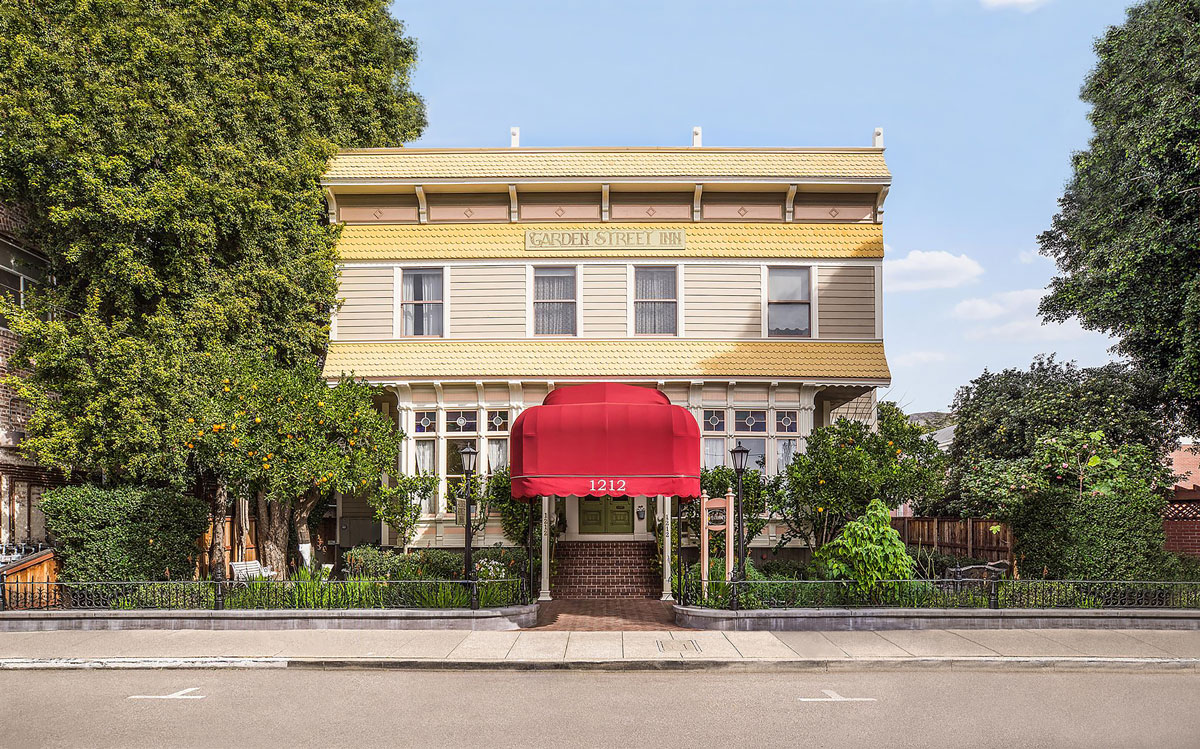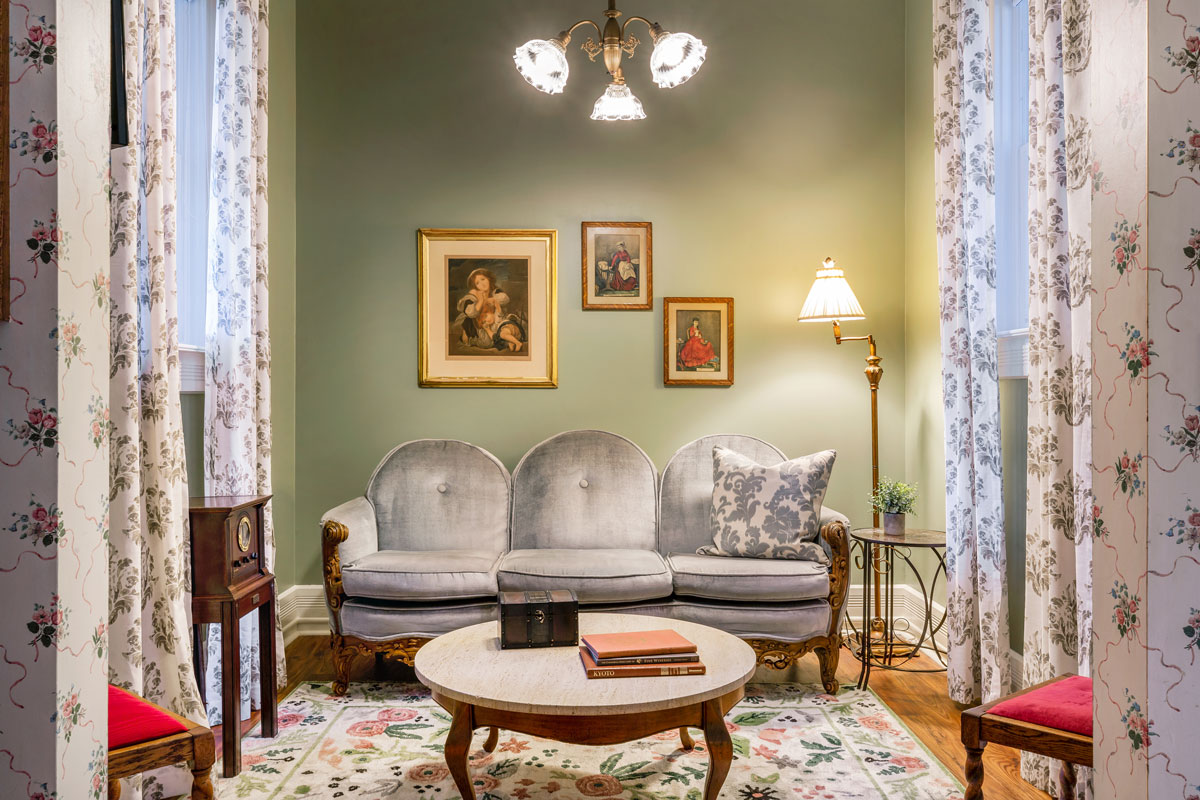Garden Street Inn, a historic Victorian Mansion located in the heart of downtown San Luis Obispo and the most recent hotel acquisition by Kirkwood Collection, had everything in place for a grand-scale renovation this fall until the pandemic hit and changed everything.

Kirkwood was challenged with figuring out a way to keep the property staff employed during the shutdown and the design department was tasked to reimagine the permit-intensive renovation ideas into equally impactful cosmetic improvements during this time. The hotel staff volunteered to “pivot” from hotel clerks and housekeepers to an integrated renovation team, and the property was able to make use of the three-and-a-half-month closure to complete a full reimagining of the property, keeping everyone employed amid total shutdown.
“When the coronavirus pandemic hit in March, our grand-scale renovation plans for Garden Street Inn were put in jeopardy and the design department was tasked to reimagine the extensive renovation ideas into creative and high-impact attainable moves,” said Alex Kirkwood, president, Kirkwood Collection. “As we walked through the property and took stock of the long-standing visual elements, including the prominent crimson red carpet that ran throughout, the muted beige and ochre walls and wallpaper on most surfaces, thoughts of the opportunity for ‘renewal’ kept coming to mind. As we began to think further about renewal, the time of the year (then spring) and the state of the mid-pandemic world, which was and continues to be a rather weighty and gloomy topic, a reset to a fresher, brighter and lighter feel for the interiors seemed appropriate and timely.”
The property’s redesign was led by Michelle McClory, design director for Kirkwood Collection. The new design delivers a modern take on the classic Victorian aesthetic with inspiration from nature.
“There is a certain grand and lofty quality to both the indoor and outdoor spaces at the Garden Street Inn,” said McClory. “This is primarily due to the very high ceilings, the accentuating cornice detail molding and the tall stacked windows both in rooms and in the dining nooks of the public spaces. In deciding on a general approach for the redesign, we knew that especially in the public areas we needed to design with verticality in mind in order to fill the space proportionally and highlight the true volume of the existing rooms.”
She continued, “Additionally, the outside front-facing facade of Garden Street is wonderfully Victorian with beautiful, delicate fretwork and elegant gingerbread detailing. The intricacy of those building features definitely inspired a high level of detail, which we infused into the interior spaces by way of layering textures, patterns, sheens, accessories, mirrors and art. The lighter paint tones of the exteriors also nudged the interior design toward a brighter, softer feel for the overall palette.”
The name itself, Garden Street Inn, provided literal inspiration in the redesign.
“In surveying the heavy furniture and darker tones, we saw an opportunity to bring the verdant feel of the outdoors in,” said McClory. “Combining these ideas for a spring renewal, an indoor garden and a refreshed palette, the design direction took hold.”
 Set against the historical backdrop of a Victorian mansion, the renovations enhanced the property’s design and history. “In choosing the wall colors, the objective was to select tones of paint that would complement and highlight the existing wood millwork and the furniture pieces we decided to keep,” she said. “With the theme of an indoor garden, we set the backdrop by choosing a spry green for walls of the main public spaces, punctuated with hits of a mature sky blue and a true leaf green, which was applied to the interior side of the entry doors. We built the rest of the palette from there. For the guestrooms, we used tones of cool subdued greens, soft mineral blues and earthy grey-browns to all act as neutrals.”
Set against the historical backdrop of a Victorian mansion, the renovations enhanced the property’s design and history. “In choosing the wall colors, the objective was to select tones of paint that would complement and highlight the existing wood millwork and the furniture pieces we decided to keep,” she said. “With the theme of an indoor garden, we set the backdrop by choosing a spry green for walls of the main public spaces, punctuated with hits of a mature sky blue and a true leaf green, which was applied to the interior side of the entry doors. We built the rest of the palette from there. For the guestrooms, we used tones of cool subdued greens, soft mineral blues and earthy grey-browns to all act as neutrals.”
In the main public spaces, the goal was to create a bold, layered environment with plenty of areas to draw the eye. Inspiration was derived from old Victorian garden courtyards, which often incorporated elements of art, stone, metal, water, winding foliage and dining all into one outdoor space. The design team added three large-scale arched windowpane mirrors to serve as a focal point and suggestion of the reflectivity, albeit on a different plane, that would be found in the water of Victorian bird baths. The mirrors also help to reflect additional light to the room and balance the tall millwork detailing surrounding the interior spaces.
The work was done by the “pivoted” hotel staff. “When we flushed out the scope and met with the hotel staff to discuss the possibility of us all rolling up our sleeves to take on the project, the staff welcomed the opportunity and volunteered to see it through,” said Kirkwood. “Now on the other side of the renovation, we have all learned many new skills and are very proud of the work we contributed.”
He continued, “Our on-site team got a crash course in how to prep, patch, sand and paint the walls and the trim, which was a sizeable and lengthy undertaking. The sheer number of surfaces that were addressed all told was astounding and quite the feat. Old beat up trim now looks new and truly shines. The staff also helped to hand polish every piece of furniture that we kept and also refreshed the wood stain of every entry door. In addition, they assisted with polishing all the brass hardware throughout the property, as well as the polishing of all railings and lighting fixtures. The level of skill and quality of work they were able to achieve was really impressive.”




